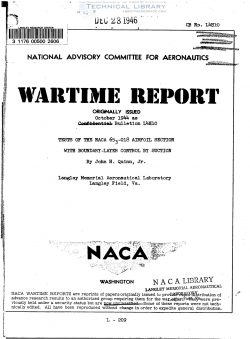naca-wr-l-209
- Version
- 106 Downloads
- 838.34 KB File Size
- 1 File Count
- April 7, 2017 Create Date
- April 7, 2017 Last Updated
Tests of the NACA 653-018 Airfoil Section with Boundary Layer Control by Suction

Tests of the NACA 655-013'airfoil section with
.boundary-layer contrOl by suction have been made in the
Langley two-dimensional low-turbulence and Langley two-
dimensional low-turbulence pressure tunnels. Slots were
tested at 30 and 75 percent and at h5 and 75 percent of 6
the airfoil chord at Reynolds numbers of 1.9 and 6.0 x 10 .
An attempt was made to remove only a moderate amount of
air through the slots and to locate the slots so that the
low-drag properties of the airfoil could be realized. The
results of these tests were compared with results for a
plain NACA 655-013 airfoil section.
A maximum section lift coefficient of 1.85 at a
Reynolds number of 6.0 x 106 was obtained on the NACA
655-018 airfoil section with boundary-layer control
when the total amount of air removed corresponded to a
flow having free-stream velocity-through an area equal
to approximately 1.2 percent of the wing area. This
lift coefficient was found at approximately the same
angle of'maximum lift as for the plain airfoil and with
suction slots at #5 and 75 percent of the airfoil chord.
The surface discontinuity, which would be found with a
flush-type sliding door placed at A5 percent of the air-
foil chord,wou1d not impair the low-drag preperties of
'this airfoil section.
INTRODUCTION
Extensive investigations have been made to develop
various types of device to increase the maximum lift of
airfoils. The most common high-lift devices are the
trailing-edge flap and the leading-edge slat. Both
these devices have disadvantages; the flap produces
high pitching moments, whereas a slat definitely limits
the region of laminar flow and thus results in high drag
even when retracted.
The purpose of the present investigation was to
determine the increase in maximum lift coefficient that
could be obtained with the arrangement of the NACA
655-018 airfoil section presented herein by using
boundary-layer control and removing only a moderate
amount of air. Locating the slots so that the low-drag
properties of the airfoil could be realized was given
primary consideration in the design. By sucking low-
energy air off the upper surface of the airfoil, separation
of the flow at high lift coefficients may be greatly
delayed and the straight portion of the lift curve may
be extended to higher angles of attack.
| File | Action |
|---|---|
| naca-wr-l-209 Tests of the NACA 653-018 Airfoil Section with Boundary Layer Control by Suction.pdf | Download |
Comment On This Post